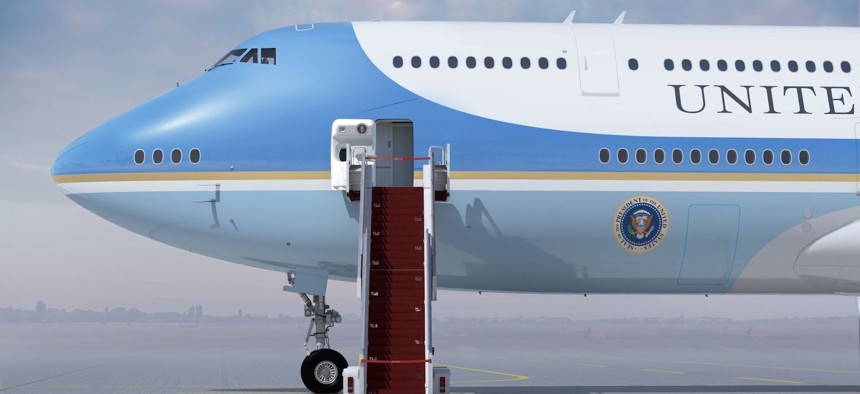
Rendering of the livery design for the “Next Air Force One,” VC-25B, March 10, 2023. Courtesy rendering
Boeing reports another huge loss on Air Force One program
The company has eaten more than $2.4 billion in losses on the program, according to a spokesperson.
This story was updated at 3:28 p.m. Oct. 25.
Boeing lost almost half a billion dollars building new Air Force One presidential jets in the third quarter of 2023, as fixed-price contracts continue to hurt the company.
The $482 million loss on the high-profile presidential plane was due to “higher estimated manufacturing costs related to engineering changes, labor instability and the resolution of supplier negotiations,” Boeing Chief Financial Officer Brian West said during the company’s third-quarter earnings call Wednesday.
Boeing has faced numerous problems with the VC-25B program, including shortages of workers and parts, that have delayed delivery of the first of two Air Force One jets until 2027. To date, the company has lost over $2.4 billion on the program, according to a company spokesperson. CEO Dave Calhoun said last year that Boeing should have never agreed to the fixed $3.9 billion price tag.
“I'll note that none of these items will impact the performance and capability of the end product. The increased estimates reflect the process by which we build the airplanes and in a fixed price environment, any unplanned hurdles can introduce unrecoverable costs,” Calhoun said Wednesday during the earnings call.
The VC-25B program was the largest contributor to the company’s losses in its defense business, which totaled $924 million this quarter.
“These are disappointing results in the quarter and year to date. This performance is below our expectations and we acknowledge that we aren't as far along in this recovery as we expected to be at this stage,” West said.
The second-largest contributor to losses for Boeing’s Defense, Space & Security (BDS) business was a satellite program that cost the company $315 million in the third quarter. The company wouldn’t identify the program, but West said the loss is “tied to customer considerations and higher estimated cost to deliver a highly innovative satellite constellation contract that we signed several years ago.”
Boeing has a “game plan” to get its defense business back on track in the next year or two, West said, and outlined multiple steps to improve performance, including “lean” initiatives, contracting disciplines, and factory improvements.
“As you know, part of the challenge we're dealing with are legacy contracts that we need to get out from under. Rest assured, we haven't signed any fixed-price development contracts, nor intend to. These moves are all fundamental to accelerating the recovery by the ’25-26 timeframe,” West said.
One of the fixed-price contracts Boeing continues to suffer from is the KC-46 tanker program. The company’s losses on the program already top $7 billion, and there’s a chance that further program deficiencies will add to those.
But despite the program’s problems, the Air Force might buy 75 more KC-46 tankers for Boeing as it looks for a bridge until the service’s stealthy next-gen aerial refueler arrives, called NGAS.
Lockheed Martin had teamed up with Airbus to compete in the next tanker competition, offering the LMXT, a new version of Airbus’ A330-based tanker, but announced earlier this week that it was bowing out of the competition. Airbus, however, still intends to compete for the next tranche of tankers.
Asked about Boeing’s position now that Lockheed has pulled out, Calhoun said, “I do like what it ultimately does for us and the competition.” However, he said, he’s “not surprised” that Airbus is still going to compete.
“That next contract matters a lot. We have to ultimately underwrite the cost and get this right and as we've committed to you all along, we're going to stay disciplined on that front,” Calhoun said.
The Boeing executives highlighted a few positive milestones this quarter, including delivering the first T-7A Red Hawk trainer aircraft to the Air Force, and securing an Army contract to build 21 AH-64E Apache helicopters.




